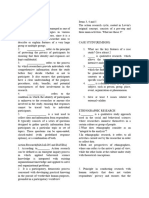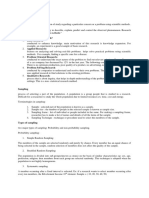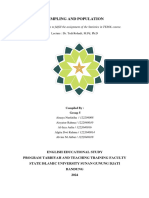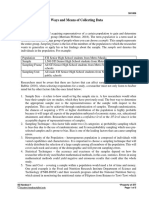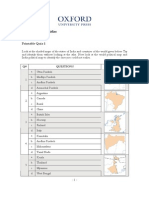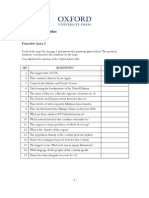0 ratings0% found this document useful (0 votes)
34 viewsJustification of The Study:: 4.1.1 Two Types of Population in Research: Target Population
Justification of The Study:: 4.1.1 Two Types of Population in Research: Target Population
Uploaded by
Paneer MomosThe document discusses population and sampling techniques for research. It defines a population as a group of individuals or objects with common characteristics, and identifies two types: the target population of interest and the accessible population that researchers can study. Sampling is selecting a representative subset or sample from the accessible population to make inferences about the target population. The key steps in sampling are identifying the target and accessible populations, then determining an appropriate sample size.
Copyright:
© All Rights Reserved
Available Formats
Download as DOCX, PDF, TXT or read online from Scribd
Justification of The Study:: 4.1.1 Two Types of Population in Research: Target Population
Justification of The Study:: 4.1.1 Two Types of Population in Research: Target Population
Uploaded by
Paneer Momos0 ratings0% found this document useful (0 votes)
34 views1 pageThe document discusses population and sampling techniques for research. It defines a population as a group of individuals or objects with common characteristics, and identifies two types: the target population of interest and the accessible population that researchers can study. Sampling is selecting a representative subset or sample from the accessible population to make inferences about the target population. The key steps in sampling are identifying the target and accessible populations, then determining an appropriate sample size.
Original Title
5
Copyright
© © All Rights Reserved
Available Formats
DOCX, PDF, TXT or read online from Scribd
Share this document
Did you find this document useful?
Is this content inappropriate?
The document discusses population and sampling techniques for research. It defines a population as a group of individuals or objects with common characteristics, and identifies two types: the target population of interest and the accessible population that researchers can study. Sampling is selecting a representative subset or sample from the accessible population to make inferences about the target population. The key steps in sampling are identifying the target and accessible populations, then determining an appropriate sample size.
Copyright:
© All Rights Reserved
Available Formats
Download as DOCX, PDF, TXT or read online from Scribd
Download as docx, pdf, or txt
0 ratings0% found this document useful (0 votes)
34 views1 pageJustification of The Study:: 4.1.1 Two Types of Population in Research: Target Population
Justification of The Study:: 4.1.1 Two Types of Population in Research: Target Population
Uploaded by
Paneer MomosThe document discusses population and sampling techniques for research. It defines a population as a group of individuals or objects with common characteristics, and identifies two types: the target population of interest and the accessible population that researchers can study. Sampling is selecting a representative subset or sample from the accessible population to make inferences about the target population. The key steps in sampling are identifying the target and accessible populations, then determining an appropriate sample size.
Copyright:
© All Rights Reserved
Available Formats
Download as DOCX, PDF, TXT or read online from Scribd
Download as docx, pdf, or txt
You are on page 1of 1
5.
JUSTIFICATION OF THE STUDY :
In this chapter we have learned about sample techniques that allow you to select and
study a small representative group of subjects and infer findings to the larger group .To
know about the detail of economic system , economic planning, objective of planning in
india .
POPULATION AND SAMPLE
4.1 POPULATION:
A research population is also known as a well-defined collection of individuals or objects
known to have similar characteristics. All individuals or objects within a certain
population usually have a common, binding characteristic or trait.
4.1.1 Two Types of Population in Research:
Target Population
Target population refers to the ENTIRE group of individuals or objects to which
researchers are interested in generalizing the conclusions. The target population usually
has varying characteristics and it is also known as the theoretical population.
Accessible Population
The accessible population is the population in research to which the researchers can
apply their conclusions. This population is a subset of the target population and is also
known as the study population. It is from the accessible population that researchers
draw their samples.
4.2 Sampling
Sampling is the process of selecting a group of subjects for a study in such a waythat
the individuals represent the larger group from which they were selected.
Thisrepresentative portion of a population is called a sample.
4.3 Steps in Sampling
1 .Identify the Target Population.
2. Identify the Accessible Population.
3. Determine the Size of the Sample.
You might also like
- Comparative Education in Developing CountriesDocument16 pagesComparative Education in Developing CountriesPoppi HSNo ratings yet
- Nursing Research & StatisticsDocument15 pagesNursing Research & StatisticsAnonymous hYMWbA100% (1)
- Research Methods NotesDocument87 pagesResearch Methods NotesJacy VykeNo ratings yet
- Population and SampleDocument11 pagesPopulation and SampleKarlina KusnadiNo ratings yet
- Accounting Research Methods Chapter 4Document81 pagesAccounting Research Methods Chapter 4Glaiza LerioNo ratings yet
- PracticaResearch-1 Q1Document63 pagesPracticaResearch-1 Q1Jyne SalvallonNo ratings yet
- Module 12 - Broad QuestionsDocument5 pagesModule 12 - Broad QuestionsmdfackideideNo ratings yet
- For Quiz 2Document2 pagesFor Quiz 2Jessa CaniesoNo ratings yet
- Assignment Papers 3 Semister IDocument13 pagesAssignment Papers 3 Semister IRatikanta DuttaNo ratings yet
- Research Methods in EducationDocument108 pagesResearch Methods in Educationbrian samNo ratings yet
- Pracres Module 9 - 14Document15 pagesPracres Module 9 - 14Prince SanjiNo ratings yet
- CH 3-Res. DesignDocument49 pagesCH 3-Res. DesignRhoda PalacioNo ratings yet
- PR1 - Handouts 5Document5 pagesPR1 - Handouts 5Donald EspirituNo ratings yet
- Basic Research TermDocument22 pagesBasic Research Termnathsujitkr1980No ratings yet
- UntitledDocument16 pagesUntitledPauleen Vivien FabiaNo ratings yet
- Research MethodologyDocument30 pagesResearch MethodologysaturnosideNo ratings yet
- Research MethodologyDocument7 pagesResearch Methodologyafiaden24No ratings yet
- BRM Unit 04Document19 pagesBRM Unit 04Tanya MalviyaNo ratings yet
- Wa0003Document19 pagesWa0003Martinez MachazNo ratings yet
- Research in Daily Life 2: Week 5Document9 pagesResearch in Daily Life 2: Week 5Abegail PanangNo ratings yet
- ResearchDocument19 pagesResearchmumaid258No ratings yet
- Practical Research Module 2ND QDocument4 pagesPractical Research Module 2ND QRaymus Avila Sta CruzNo ratings yet
- Inquiries, Investigation and Immersion SummaryDocument3 pagesInquiries, Investigation and Immersion Summarycaesar ian bilbaoNo ratings yet
- Kanmany Gru ExamDocument14 pagesKanmany Gru ExamSankeran JeganmohanNo ratings yet
- Reliance Mart Vs Big Bazaar CBBDocument51 pagesReliance Mart Vs Big Bazaar CBBJaiNo ratings yet
- Research MethodologyDocument48 pagesResearch MethodologyShah Zaib HayatNo ratings yet
- Business Research Method All in OneDocument71 pagesBusiness Research Method All in Onebibeek.1029No ratings yet
- Definition of Sampling, Terminologies - DIAZDocument23 pagesDefinition of Sampling, Terminologies - DIAZJhomari Mollejon DiazNo ratings yet
- ILAP (WK 3)Document16 pagesILAP (WK 3)Jazer Batacan LeuterioNo ratings yet
- Sampling in ResearchDocument9 pagesSampling in ResearchDn Aju PhilipNo ratings yet
- CTU Masteral Exercise 5 - November 4, 2023Document8 pagesCTU Masteral Exercise 5 - November 4, 2023Anything For YouNo ratings yet
- Report Mwalimu11Document6 pagesReport Mwalimu11Zawadi Ally NkulikwaNo ratings yet
- Tesoro Research RPCDocument16 pagesTesoro Research RPCRalph Perez SinoyNo ratings yet
- Practical Research 1Document3 pagesPractical Research 1Abi De GuzmanNo ratings yet
- Qualitative Sampling Techniques Elmusharaf 2018Document24 pagesQualitative Sampling Techniques Elmusharaf 2018matthewamoako64No ratings yet
- Resume of Quantitative RM Survey ResearchDocument3 pagesResume of Quantitative RM Survey ResearchNano NinoNo ratings yet
- Introduction - Meaning, Objectives, Significance of ResearchDocument12 pagesIntroduction - Meaning, Objectives, Significance of ResearchKaranpreet KaurNo ratings yet
- Research Module 3Document7 pagesResearch Module 3Joy Remanes LlobreraNo ratings yet
- Data Collection Methods and Research DesignDocument14 pagesData Collection Methods and Research DesignLakshmish Gopal100% (1)
- Unit 1: Careful Investigation or Inquiry Specially Through Search For New Facts in Any Branch of Knowledge."Document6 pagesUnit 1: Careful Investigation or Inquiry Specially Through Search For New Facts in Any Branch of Knowledge."Sayed Abdul SaboorNo ratings yet
- Basics of Research: Mrs. Kiran Prabha Jain Mrs. Anjali A. JainDocument2 pagesBasics of Research: Mrs. Kiran Prabha Jain Mrs. Anjali A. JainKrishan Bir SinghNo ratings yet
- Media ResearchDocument17 pagesMedia ResearchDragenvoygerNo ratings yet
- Research Study I: PG Diploma in PharmacyDocument41 pagesResearch Study I: PG Diploma in PharmacyNidhi Pandey UpretiNo ratings yet
- Chapter 1 What Is Nursing ResearchDocument35 pagesChapter 1 What Is Nursing ResearchJanzell Anne Borja AlbaniaNo ratings yet
- Group 4 - Sampling in StatisticsDocument10 pagesGroup 4 - Sampling in StatisticsfitalokainnaNo ratings yet
- WEEK 3 RESEARCH 1 UNIT 2 Qualitative Reasearch and Its Importance On Daily LifeDocument39 pagesWEEK 3 RESEARCH 1 UNIT 2 Qualitative Reasearch and Its Importance On Daily LifeieshalomagueNo ratings yet
- Research ModuleDocument66 pagesResearch ModuleGreatson MfulaNo ratings yet
- ResearchesDocument3 pagesResearchesDenisse Kharl CandiaNo ratings yet
- Chapter 5Document2 pagesChapter 5Lourene Jauod- GuanzonNo ratings yet
- Ways and Means of Collecting Data: I. Sampling ConceptsDocument5 pagesWays and Means of Collecting Data: I. Sampling ConceptsZuea Mae TarrayoNo ratings yet
- Types of KnowledgeDocument28 pagesTypes of KnowledgePraveen KumarNo ratings yet
- MethodologyDocument35 pagesMethodologyhoormohameed2019No ratings yet
- Populations and Samples: Pracre1 Lec10Document8 pagesPopulations and Samples: Pracre1 Lec10Angelo CarreonNo ratings yet
- PR Week1 D1Research DesignDocument34 pagesPR Week1 D1Research DesignlurainejuguilonNo ratings yet
- PHENODocument15 pagesPHENOBaby SufiNo ratings yet
- PR 1 4TH QTR ReviewerDocument8 pagesPR 1 4TH QTR ReviewerVinz AlilingNo ratings yet
- Lecture CHAPTER 5Document4 pagesLecture CHAPTER 5GDELA CRUZ, PRINCEZKHA ANN D.No ratings yet
- Participatory Action Research for Evidence-driven Community DevelopmentFrom EverandParticipatory Action Research for Evidence-driven Community DevelopmentNo ratings yet
- Research Methods and Methods in Context Revision Notes for AS Level and A Level Sociology, AQA FocusFrom EverandResearch Methods and Methods in Context Revision Notes for AS Level and A Level Sociology, AQA FocusNo ratings yet
- Mission Statement: SBI Articulates Nine Core ValuesDocument6 pagesMission Statement: SBI Articulates Nine Core ValuesPaneer MomosNo ratings yet
- E - Id Int, Name Varchar (25), Adderess Varchar (15), Salary IntDocument4 pagesE - Id Int, Name Varchar (25), Adderess Varchar (15), Salary IntPaneer MomosNo ratings yet
- Table of ContentsDocument1 pageTable of ContentsPaneer MomosNo ratings yet
- Oxford School Atlas: 33 EditionDocument1 pageOxford School Atlas: 33 EditionPaneer MomosNo ratings yet
- Oxford School Atlas: 33 EditionDocument1 pageOxford School Atlas: 33 EditionPaneer MomosNo ratings yet
- Oxford School Atlas: 33 EditionDocument1 pageOxford School Atlas: 33 EditionPaneer MomosNo ratings yet
- Oxford School Atlas: 33 EditionDocument2 pagesOxford School Atlas: 33 EditionPaneer MomosNo ratings yet
- Oxford School Atlas: 33 EditionDocument2 pagesOxford School Atlas: 33 EditionPaneer MomosNo ratings yet








